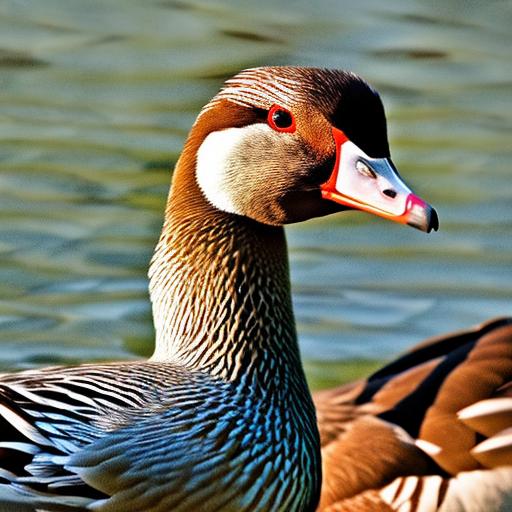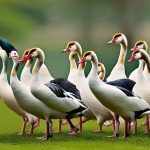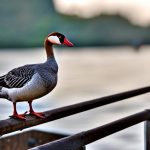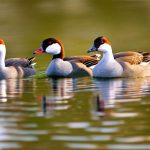Keeping geese and ducks together can be a rewarding and enjoyable experience for poultry enthusiasts. Geese and ducks are both waterfowl species that have similar needs and can thrive in the same environment. By raising them together, you can benefit from their pest control abilities, soil fertilization, companionship, and entertainment. In this article, we will explore the benefits of keeping geese and ducks together, understand their differences, choose the right breeds, provide housing and shelter, discuss feeding and nutrition, address health and disease prevention, consider socialization and behavioral aspects, explore egg production and management, and provide tips for successful integration.
Key Takeaways
- Keeping geese and ducks together can be a great way to diversify your flock and provide a range of benefits.
- Geese and ducks have different needs and behaviors, but can coexist peacefully with proper management.
- Choosing the right breeds for your flock is important, as some breeds may be more compatible than others.
- Housing and shelter requirements for geese and ducks can vary, but both need access to water and protection from predators.
- Feeding and nutrition for geese and ducks should be tailored to their specific needs, and health and disease prevention should be a top priority.
Benefits of Keeping Geese and Ducks Together
One of the main benefits of keeping geese and ducks together is their pest control abilities. Both geese and ducks are natural foragers and will eat insects, slugs, snails, and other pests that may harm your garden or crops. They can help keep your property free from unwanted pests without the need for harmful chemicals or pesticides.
Another benefit is soil fertilization. Geese and ducks produce nutrient-rich manure that can be used to fertilize your garden or fields. Their droppings are high in nitrogen, phosphorus, and potassium, which are essential nutrients for plant growth. By allowing them to roam freely in your garden or providing them access to specific areas, you can improve the fertility of your soil naturally.
Geese and ducks also provide companionship for each other. They are social animals that thrive in the company of their own kind. By keeping them together, you are providing them with a sense of belonging and reducing the risk of loneliness or stress. They will engage in social interactions, such as grooming each other or swimming together, which can contribute to their overall well-being.
Lastly, keeping geese and ducks together can be entertaining for the owner. These birds have unique personalities and behaviors that can be fascinating to observe. From their playful splashing in water to their synchronized waddling, they can bring joy and amusement to your daily life. Watching them interact with each other and exploring their natural instincts can be a source of relaxation and entertainment.
Understanding the Differences Between Geese and Ducks
Before keeping geese and ducks together, it is important to understand the differences between these two species. Geese are generally larger than ducks, with longer necks and larger bodies. They have a distinctive honking sound and are known for their aggressive behavior when protecting their territory or young. Ducks, on the other hand, have shorter necks and smaller bodies. They have a quacking sound and are generally more docile compared to geese.
In terms of behavior, geese are known for their strong flocking instinct and loyalty to their mate or family group. They are highly protective of their territory and will often chase away intruders or predators. Ducks, on the other hand, are more social and tend to form larger flocks. They are less territorial and may not exhibit the same level of aggression as geese.
Nutritionally, geese and ducks have similar dietary requirements. They both require a balanced diet that includes grains, greens, insects, and access to fresh water for drinking and bathing. However, geese have a higher need for grass or pasture compared to ducks, as it is an essential part of their diet.
Choosing the Right Breeds for Your Flock
When choosing breeds for your flock of geese and ducks, there are several factors to consider. First, consider the climate in your area. Some breeds are better suited for colder climates, while others thrive in warmer regions. It is important to choose breeds that can withstand the temperature extremes in your area.
Popular breeds for geese include Toulouse, Embden, and Chinese geese. Toulouse geese are known for their large size and calm temperament. Embden geese are also large and are often raised for meat production. Chinese geese are smaller and known for their striking appearance with a knob on their beak.
For ducks, popular breeds include Pekin, Rouen, and Khaki Campbell. Pekin ducks are the most common breed and are known for their white feathers and meat production. Rouen ducks have a similar appearance to wild Mallard ducks and are often raised for meat or exhibition purposes. Khaki Campbell ducks are known for their high egg production and are popular among backyard poultry keepers.
Hybrid breeds, such as the Pekin-Rouen cross or the Khaki Campbell-Indian Runner cross, can also be considered. These hybrids often combine the desirable traits of both parent breeds, such as increased egg production or better meat quality.
Housing and Shelter Requirements for Geese and Ducks
Geese and ducks require suitable housing and shelter to protect them from predators, provide them with a comfortable environment, and ensure their overall well-being. There are different types of housing options available, including coops, sheds, or dedicated poultry houses.
The housing should provide enough space for the birds to move around comfortably. Geese require more space compared to ducks due to their larger size. A general guideline is to provide at least 10 square feet per goose and 4-6 square feet per duck. The housing should also have proper ventilation to prevent the buildup of moisture or ammonia from their droppings.
Bedding materials such as straw or wood shavings should be provided to keep the birds comfortable and to absorb moisture. Nesting boxes should also be provided for ducks if you plan on breeding them. These boxes should be filled with straw or other suitable nesting materials to encourage egg-laying behavior.
Feeding and Nutrition for Geese and Ducks

Geese and ducks have similar nutritional requirements and can be fed a balanced diet that includes grains, greens, insects, and access to fresh water. A commercial poultry feed formulated specifically for waterfowl can also be provided to ensure they receive all the necessary nutrients.
It is important to provide a varied diet to meet their nutritional needs. This can include grains such as corn, wheat, or barley, as well as leafy greens like lettuce or spinach. Insects and worms can be offered as treats or as a source of protein. Fresh water should always be available for drinking and bathing.
Feeding schedules can vary depending on the age and purpose of your birds. Young birds may require more frequent feedings, while adult birds can be fed once or twice a day. It is important to monitor their body condition and adjust the feeding amounts accordingly to prevent obesity or malnutrition.
Health and Disease Prevention for Geese and Ducks
Geese and ducks are generally hardy birds, but they can still be susceptible to certain health issues. Common health issues in waterfowl include respiratory infections, parasites, and foot problems. It is important to take preventative measures to keep your flock healthy.
Preventative measures include providing a clean and dry environment, regular cleaning of their housing, and proper nutrition. Regular veterinary check-ups are also recommended to monitor their overall health and address any potential issues early on.
Signs of illness in geese and ducks can include lethargy, loss of appetite, changes in behavior, or abnormal droppings. If you notice any of these signs, it is important to seek veterinary advice promptly to prevent the spread of disease within your flock.
Socialization and Behavioral Considerations for Geese and Ducks
Geese and ducks are social animals that benefit from interaction with other birds. If you are introducing new birds to your flock, it is important to do so gradually to minimize stress and aggression. Provide a separate area for the new birds initially, allowing them to see and hear each other without direct contact. After a period of time, you can gradually introduce them to each other under supervision.
Training and handling can also play a role in the socialization of geese and ducks. By spending time with your birds and providing positive reinforcement, you can build trust and establish a bond. This can make handling and management easier, especially when it comes to tasks such as health checks or moving them to different areas.
Behavioral issues such as aggression or excessive noise can sometimes arise in geese and ducks. Aggression is more common in geese, especially during breeding season or when protecting their territory. Providing adequate space, resources, and distractions can help manage aggression. Excessive noise can be addressed by identifying the cause and providing environmental enrichment or distractions.
Egg Production and Management for Geese and Ducks
Geese and ducks have different egg-laying habits compared to chickens. Geese typically lay fewer eggs per year, with an average of 20-40 eggs depending on the breed. They also have a longer incubation period of around 30 days.
Ducks, on the other hand, are known for their high egg production. Khaki Campbell ducks, for example, can lay up to 300 eggs per year. Ducks also have a shorter incubation period of around 28 days.
Collecting and storing eggs should be done regularly to prevent them from becoming dirty or damaged. Eggs should be stored in a cool and dry place with proper ventilation. It is important to turn the eggs daily if you plan on incubating them to ensure proper development.
Incubation and hatching can be done naturally by allowing the female duck or goose to sit on the eggs, or it can be done using an artificial incubator. Natural incubation requires a broody female that will stay on the nest and provide the necessary warmth and humidity for the eggs to hatch. Artificial incubation requires a controlled environment with specific temperature and humidity settings.
Tips for Successful Integration of Geese and Ducks in Your Flock
Integrating new geese or ducks into your existing flock can be a smooth process if done correctly. It is important to introduce new birds gradually to minimize stress and aggression. Provide a separate area for the new birds initially, allowing them to see and hear each other without direct contact. After a period of time, you can gradually introduce them to each other under supervision.
Managing aggression is also important when integrating new birds. Aggression is more common in geese, especially during breeding season or when protecting their territory. Providing adequate space, resources, and distractions can help manage aggression. If necessary, separating aggressive individuals may be required to maintain harmony within the flock.
Providing adequate resources such as food, water, and nesting areas is essential to prevent competition and aggression. Ensure that there are enough feeding and drinking stations for all birds, as well as sufficient nesting boxes for ducks if you plan on breeding them.
Keeping geese and ducks together can be a rewarding experience that offers numerous benefits. From pest control to soil fertilization, these waterfowl species can contribute to the overall health and well-being of your property. By understanding their differences, choosing the right breeds, providing suitable housing and shelter, addressing their nutritional needs, taking preventative measures for health, considering socialization and behavioral aspects, managing egg production, and integrating new birds successfully, you can create a harmonious flock that brings joy and fulfillment to your poultry keeping journey. So why not give it a try?
If you’re interested in keeping geese and ducks together, you may find this article on Poultry Wizard quite helpful. It discusses the benefits and considerations of cohabitating geese and ducks in the same space. From providing companionship to enhancing security, there are several advantages to keeping these waterfowl species together. To learn more about this topic, check out the article here.
FAQs
What are the benefits of keeping geese and ducks together?
Keeping geese and ducks together can provide several benefits, such as reducing the risk of predators attacking them, improving their socialization skills, and enhancing their overall health and well-being.
What are the challenges of keeping geese and ducks together?
One of the main challenges of keeping geese and ducks together is that they have different dietary needs, which can lead to nutritional imbalances if not managed properly. Additionally, geese tend to be more aggressive than ducks, which can result in injuries or even death if they are not properly supervised.
What should I consider before keeping geese and ducks together?
Before keeping geese and ducks together, you should consider factors such as the size of your enclosure, the availability of food and water, and the temperament of your birds. It is also important to ensure that your birds have access to adequate shelter and protection from predators.
What should I feed my geese and ducks?
Geese and ducks have different dietary needs, but both require a balanced diet that includes a mix of grains, vegetables, and protein sources such as insects or fish. It is important to provide them with access to fresh water at all times, as well as grit to aid in digestion.
How can I prevent aggression between my geese and ducks?
To prevent aggression between geese and ducks, it is important to provide them with enough space to move around and establish their own territories. You can also try introducing new birds gradually and providing them with plenty of distractions, such as toys or treats, to keep them occupied. Additionally, separating aggressive birds from the rest of the flock may be necessary in some cases.
Meet Walter, the feathered-friend fanatic of Florida! Nestled in the sunshine state, Walter struts through life with his feathered companions, clucking his way to happiness. With a coop that’s fancier than a five-star hotel, he’s the Don Juan of the chicken world. When he’s not teaching his hens to do the cha-cha, you’ll find him in a heated debate with his prized rooster, Sir Clucks-a-Lot. Walter’s poultry passion is no yolk; he’s the sunny-side-up guy you never knew you needed in your flock of friends!







